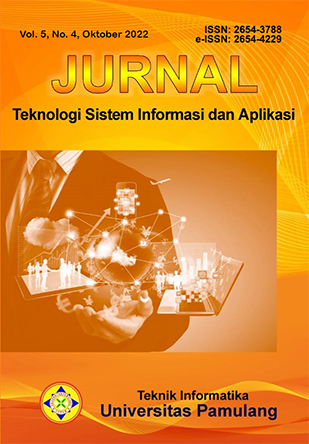Pengembangan Aplikasi Web Penerimaan Beasiswa Menggunakan Model Waterfall
Keywords:
Achievement, Scholarship, Application, WebAbstract
In this modern era education is very important, but we can find some students or students who cannot continue their education due to costs, the provision of educational assistance from the government can help underprivileged students or students, the information we get, we create a web-based application that help students or students to get scholarships, from applications that we develop or make using several methods, sorting data, how to manage this web-based application from applicants, will be re-managed and put into a list, this based application can be a place of submission by web-based, submission of scholarship data can be viewed by registrants on the web can view the schedule or scholarship data, the data source that displays this web-based application is made to make it easier for students or students who want to study, but this web-based application is made only as a bridge or assistance to eat go to schools or universities that are worthy of education, the creation of web-based applications is intentionally not made with some complicated tools, only focused on applying for scholarships that may be able to help students or students who want further education.References
Agustiyanti, (2018), "Lulusan SMK Paling Banyak Menganggur,"
Ahmad, A. Chamid & Alif, C. Murti, “ Kombinasi Metode Ahp Dan Topsis Pada Sistem Pendukung Keputusan,†in Snatif, 2017, pp. 115–119
Andalan, Y. B., Sagirani, T., & Lemantara, J. (2018, Sep 1). Rancang Bangun Aplikasi Pendaftaran dan Seleksi Beasiswa Dengan Menggunakan Metode SAW. Jurnal JSIKA, Vol 7, No 4.
Bahri. K. & Ghea. D. Rahmadiane, “Pengaruh Persepsi, Akreditasi Prodi, Dan Promosi Terhadap Keputusan Memilih Program Studi Akuntansi Pada Politeknik Harapan Bersama,†J. Inspirasi Bisnis dan Manaj., vol. 1, no. 2, p. 145, 2017, doi: 10.33603/jibm.v1i2.866.
Herdiansah, A., Handayani, N., & Kurniawan, A. (2019). Development of Decision Support SystemsSelection of Employee Acceptance Using Weighted Product Method. Journal of Information System and Informatics, 1(2), 87–97.
Herdiansah, A. (2020). Sistem Pendukung Keputusan Referensi Pemilihan Tujuan Jurusan teknik Di Perguruan. Jurnal MATRIK, 19(2), 223–234.
Muchariroh, U. (2018). Sistem Pendukung Keputusan Untuk Menentukan Penerima Beasiswa Kurang Mampu Menggunakan Metode SAW. Jurnal Simple Additive Weighting, 4-9.
Muhammad, L. I. (2020). Pendukung Keputusan Pemilihan Calon Penerima Beasiswa di SMK Ummul Quro Menggunakan Metode MOORA. Kecerdasan Buatan (Artificial Intelligence).
Mulia, R & Rosi K, S, Sistem Pendukung Keputusan Pemilihan Jurusan pada SMK Putra Nusantara Jakarta Menggunakan Metode Analytical Hierarchy Process (AHP). Simetris J. Tek. Mesin, Elektro dan Ilmu Komput., vol. 9, no. 1, (2018).
Khoirun, N. “Metode Moora Dan Waspas Untuk Pengambilan Keputusan Penentuan Prioritas Dalam Peningkatan Kualitas Mata Pelajaran,†J. Teknol. Inf., vol. 4, no. 1, pp. 22–27, 2020, doi: 10.36294/jurti.v4i1.1173.
Downloads
Published
How to Cite
Issue
Section
License
Copyright (c) 2022 Sri Mulyati, Fabian Syawali, Ilham Ngudi Slameto, Rifaldi Setia Nugraha, Niki Ratama

This work is licensed under a Creative Commons Attribution-NonCommercial 4.0 International License.
Authors who publish with this journal agree to the following terms:
- Authors retain copyright and grant the journal right of first publication with the work simultaneously licensed under a Creative Commons Attribution License that allows others to share the work with an acknowledgement of the work's authorship and initial publication in this journal.
- Authors are able to enter into separate, additional contractual arrangements for the non-exclusive distribution of the journal's published version of the work (e.g., post it to an institutional repository or publish it in a book), with an acknowledgement of its initial publication in this journal.
- Authors are permitted and encouraged to post their work online (e.g., in institutional repositories or on their website) prior to and during the submission process, as it can lead to productive exchanges, as well as earlier and greater citation of published work (See The Effect of Open Access).
Jurnal Teknologi Sistem Informasi dan Aplikasi have CC BY-NC or an equivalent license as the optimal license for the publication, distribution, use, and reuse of scholarly work.
In developing strategy and setting priorities, Jurnal Teknologi Sistem Informasi dan Aplikasi recognize that free access is better than priced access, libre access is better than free access, and libre under CC BY-NC or the equivalent is better than libre under more restrictive open licenses. We should achieve what we can when we can. We should not delay achieving free in order to achieve libre, and we should not stop with free when we can achieve libre.
This work is licensed under a Creative Commons Attribution-NonCommercial 4.0 International (CC BY-NC 4.0) License
YOU ARE FREE TO:
- Share - copy and redistribute the material in any medium or format
- Adapt - remix, transform, and build upon the material for any purpose, even commercially.
- The licensor cannot revoke these freedoms as long as you follow the license terms



_2020_-_7(2)_2024_-_Thumbnail.png)












